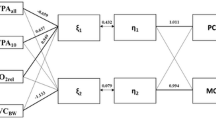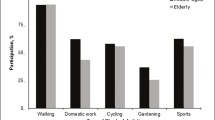Abstract
Background
Previous studies investigated the associations between health-related quality of life (HRQoL) and self-reported physical activity (PA) and/or self-reported physical fitness which are not the most reliable methods to assess PA and fitness. Therefore, this study aimed to examine the associations between HRQoL and each of objectively assessed habitual PA and physical fitness.
Methods
Eighty-five community-dwelling older adults (60–83 years) completed assessments for PA (counts/min and steps/day using accelerometers), physical fitness (six-minute walk test [6MWT] and hand-grip strength), and self-reported HRQoL (using the eight subscales of the SF-36). In adjusted logistic regression models, the upper quartile was compared against the lower three quartiles of scores on each HRQoL subscale. Results report the odds ratios that were significant in the adjusted models at P < 0.05.
Results
Individuals with higher PA levels assessed by counts/min were more likely to score higher on physical functioning (PF) subscale (OR = 1.90). Individuals with superior 6MWT performance were more likely to score higher on PF (OR = 1.87), role limitations due to physical problems (RP) (OR = 1.95), and vitality (VT) (OR = 1.79). Individuals with superior hand-grip strength were more likely to score higher on RP (OR = 2.37) and VT (OR = 1.83).
Conclusions
Objectively assessed PA and physical fitness measures were positively associated with physical health HRQoL subscales as reported by community-dwelling older adults.
Similar content being viewed by others
Abbreviations
- BMI:
-
Body mass index
- BP:
-
Bodily pain
- GH:
-
General health
- HRQoL:
-
Health-related quality of life
- M:
-
Mean
- MH:
-
Mental health
- OR:
-
Odds ratio
- PA:
-
Physical activity
- PF:
-
Physical functioning
- QoL:
-
Quality of life
- RE:
-
Role limitations due to emotional problems
- RP:
-
Role limitations due to physical problems
- SD:
-
Standard deviation
- SF:
-
Social functioning
- SF-36:
-
Medical outcomes study 36-item short-form health study
- VO2max :
-
Maximum oxygen consumption
- VT:
-
Vitality
- 6MWT:
-
Six-minute walk test
References
Hunt, S., & McEwen, J. (1980). The development of a subjective health indicator. Sociology of Health & Illness, 2(3), 231–246.
Mossey, J. M., & Shapiro, E. (1982). Self-rated health: A predictor of mortality among the elderly. American Journal of Public Health, 72(8), 800–808.
Brown, D., et al. (2004). Associations between physical activity dose and health-related quality of life. Medicine and Science in Sports and Exercise, 36(5), 890–896.
Kroenke, C. H., et al. (2008). Prospective change in health-related quality of life and subsequent mortality among middle-aged and older women. American Journal of Public Health, 98(11), 2085–2091.
Wannamethee, G., & Shaper, A. G. (1991). Self-assessment of health status and mortality in middle-aged british men. International Journal of Epidemiology, 20(1), 239–245.
Rejeski, W. J., & Mihalko, S. L. (2001). Physical activity and quality of life in older adults. Journals of Gerontology. Series A, Biological Sciences and Medical Sciences, 56(90002), 23–35.
Leinonen, R., Heikkinen, E., & Jylha, M. (2001). Predictors of decline in self-assessments of health among older people—A 5-year longitudinal study. Social Science and Medicine, 52(9), 1329–1341.
Lorraine, P., Hammock, R., & Blanton, J. (2005). Predictors of self-rated health status among Texas residents. Preventing Chronic Disease, 2(4), 12.
Bowling, A., et al. (1999). Short Form 36 (SF-36) health survey questionnaire: Which normative data should be used? Comparisons between the norms provided by the omnibus survey in Britain, the health survey for England and the Oxford healthy life survey. J Public Health, 21(3), 255–270.
Murphy, S. (2009). Review of physical activity measurement using accelerometers in older adults: Considerations for research design and conduct. Preventive Medicine, 48(2), 108–114.
Cochrane, T., et al. (1998). Exercise, physical function and health perceptions of older people. Physiotherapy, 84(12), 598–602.
King, A. C., et al. (2000). Comparative effects of two physical activity programs on measured and perceived physical functioning and other health-related quality of life outcomes in older adults. Journals of Gerontology. Series A, Biological Sciences and Medical Sciences, 55(2), M74–M83.
Spirduso, W., & Cronin, D. (2001). Exercise dose-response effects on quality of life and independent living in older adults. Medicine and Science in Sports and Exercise, 33(6 Suppl), S598–S608. discussion S609–S610.
Mark, A., & Janssen, I. (2008). Dose-response relation between physical activity and blood pressure in youth. Medicine and Science in Sports and Exercise, 40(6), 1007–1012.
Freedson, P., Melanson, E., & Sirard, J. (1998). Calibration of the computer science and applications, Inc. accelerometer. Medicine and Science in Sports and Exercise, 30(5), 777–781.
Lord, S. R., & Menz, H. B. (2002). Physiologic, psychologic, and health predictors of 6-minute walk performance in older people. Archives of Physical Medicine and Rehabilitation, 83(7), 907–911.
Rikli, R. E., & Jones, C. J. (1998). The reliability and validity of a 6-minute walk test as a measure of physical endurance in older adults. Journal of Aging and Physical Activity, 6(4), 363–375.
Kervio, G., Carre, F., & Ville, N. S. (2003). Reliability and intensity of the six-minute walk test in healthy elderly subjects. Medicine and Science in Sports and Exercise, 35(1), 169–174.
Van Heuvelen, M. J., et al. (1998). Physical fitness related to age and physical activity in older persons. Medicine and Science in Sports and Exercise, 30(3), 434–441.
Ware, J., & Sherbourne, C. (1992). The MOS 36-item short-form health survey (SF-36). I. Conceptual framework and item selection. Medical Care, 30(6), 473–483.
Ferreira, P. L. (1998). A medição do estado de saúde: criação da versão portuguesa do MOS SF-36, in Centro de Estudos e Investigação em Saúde, Faculdade de Economia. Coimbra: Universidade de Coimbra.
Anderson, C., Laubscher, S., & Burns, R. (1996). Validation of the short form 36 (SF-36) Health Survey Questionnaire among stroke patients. Stroke, 27(10), 1812–1816.
Lyons, R. A., Perry, I. M., & Littlepage, B. N. C. (1994). Evidence for the validity of the short-form 36 questionnaire (SF-36) in an elderly population. Age and Ageing, 23(3), 182–184.
Parker, S. G., et al. (1998). Measuring health status in older patients. The SF-36 in practice. Age and Ageing, 27(1), 13–18.
Ware, J. E., et al. (1993). SF-36 health survey: Manual and interpretation guide. Lincoln, RI: QualityMetric Inc.
Redelmeier, D., Bayoumi, A., et al. (1997). Interpreting small differences in functional status: The Six Minute Walk test in chronic lung disease patients. American Journal of Respiratory and Critical Care Medicine, 155(4), 1278–1282.
Rikli, R. E., & Jones, C. J. (1999). Functional fitness normative scores for community-residing older adults, ages 60–94. Journal of Aging and Physical Activity, 7(2), 162–181.
Cruz-Jentoft, A. J., et al. (2010). Sarcopenia: European consensus on definition and diagnosis: Report of the European working group on sarcopenia in older people. Age and Ageing, 39(4), 412–423.
Sayer, A. A., et al. (2006). Is grip strength associated with health-related quality of life? Findings from the Hertfordshire cohort study. Age and Ageing, 35, 409–415.
Daltroy, L., et al. (1999). Discrepancies between self-reported and observed physical function in the elderly: The influence of response shift and other factors. Social Science and Medicine, 48(11), 1549–1561.
Acknowledgments
The authors would like to thank to the volunteers of this study. Without their selfless contribution, this study would not have been possible. Grants from the Portuguese Foundation for Science and Technology (PTDC/DES/108780/2008 and SFRH/BD/33124/2007) supported this research.
Author information
Authors and Affiliations
Corresponding author
Rights and permissions
About this article
Cite this article
Wanderley, F.A.C., Silva, G., Marques, E. et al. Associations between objectively assessed physical activity levels and fitness and self-reported health-related quality of life in community-dwelling older adults. Qual Life Res 20, 1371–1378 (2011). https://doi.org/10.1007/s11136-011-9875-x
Accepted:
Published:
Issue Date:
DOI: https://doi.org/10.1007/s11136-011-9875-x




